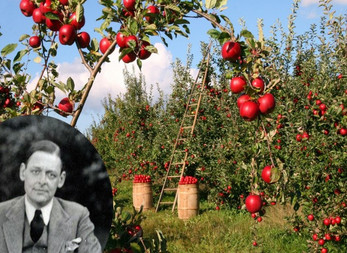Harvesting Time
A downloadable project
Harvesting Time is inspired by T.S. Eliot’s The Three Voices of Poetry and the themes of time, individual vs. collective voice, and the seasonal cycles of nature, I have created a literal exchange of voice between the living and the dead, across time. In this piece, Eliot recites one of my poems, in his own voice, while I in turn read an introduction drawn from his poetry, in mine.
Using Audacity audio software and existing recordings of Eliot reading his work (principally his “Four Quartets”, which I quote in my introduction), I carefully extracted words and syllables from these recordings, then reassembled (or as needed, built) the words into a recitation of my own poem, “Harvesting Time". Eliot's voice is quite distinctive, and he is noted for his blended, American-British accent. Therefore, when creating this new recording I paid particular attention to Eliot’s individual pacing, pitch, and intonation, as I sought to create a natural sound using Eliot’s unique musicality of speech.
“Harvesting Time” speaks to the way that nature “harvests” or recycles time, depicted by the seasonal cycle of apple trees: their creation of life out of death, as the spring blossoms give way to fall apples, which then seed a new generation of trees the following spring. The poem essentially “re-seeds” itself as well, as the words of each stanza are rearranged and repeated in new configurations, moving through the cycle of the seasons. The process by which I harvested the words from Eliot’s recordings, then, also uses this same recycling technique; I re-used the same recorded/built words in new configurations for each stanza, adjusting them accordingly to create the most natural sound. Much like assembling a puzzle, each word had to be carefully crafted, ensuring its fit with the words before and after, each time it was used. This was particularly challenging, as Eliot does not read in one consistent “voice” in the recordings, but rather was known for employing a variety of dramatic personae, and their associated voices, throughout his poems.
Indeed, Eliot often examined and explored the concept of voice in his poetry, and the ways in which voice may be distinguished from poet. In “The Three Voices of Poetry”, he states that “the final handing over, so to speak, of the poem to an unknown audience, for what the audience will make of it, seems to me the consummation of the process begun in solitude and without thought of the audience, the long process of gestation of the poem, because it marks the final separation of the poem from the author.” Though he refers in this essay to the metaphorical voices of the poet, he admits that there may well exist more than three voices in a poem. I believe that it is in this final separation that another voice may be heard- the actual, physical voice of the poet themselves. With the advent of audio recording, the poet’s voice could be separated from their body, and much like their poems, begin to take on a life of its own- even outliving the poet themselves.
Eliot’s “Four Quartets” opens with the lines, “Time present and time past / Are both perhaps present in time future / And time future contained in time past.” Throughout the poem he similarly explores the cyclical nature of time and memory: the interchange and interdependent existence of life and death, as represented by the seasons. Though written out of the devastation of the ongoing second World War, with a perpetual drive to move forward from the past, the poem ends with memories from Eliot’s childhood, his time in New Hampshire playing amongst apple trees, and the declaration that “the last of earth left to discover / Is that which was the beginning.” Physically as well as metaphorically, Eliot's voice contained elements of his past and his present- his accent a blend of his youth in America with his adulthood in England, and his words drawing on both the death and destruction of the war as well as his hope for a remembered peace. In his words and voice I have discovered a fruitful harvest, reimagining the seeds he planted nearly a century ago to create harmony between the living and the dead, a unity of past, present, and future.
(Images: Photo of Orchard by lumix2004 from Pixabay /Photo of T.S. Eliot by Lady Ottoline Morrell)
| Status | Released |
| Category | Other |
| Author | Jess Skyleson |
